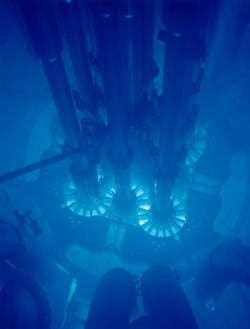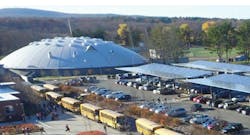Sign of the Times: Oracle Designing Future GW-Scale Data Center Powered by SMR Nuclear
Software and cloud-based services giant Oracle is the latest major tech company embracing the concept of small modular reactor (SMR) nuclear as the most energy dense and sustainable microgrid option for future data centers.
Earlier this week, company founder and Chairman Larry Ellison told investors and media that it planned to build a gigawatt-scale data center that will be powered by three nearby SMR reactors. During the quarterly earnings call, Ellison indicated the nuclear-powered data center was under design but didn’t give a concrete timeline.
Most industry observers predict that the earliest SMR projects would not come online until the 2030s.
The stunning rise in data center energy demand brought on by the growth of artificial intelligence and cloud-based computing capacity is compelling many tech companies to pursue the possibilities of small nuclear power, although no SMR has yet been built or even licensed to begin construction for commercial purposes. Idaho National Lab is testing advanced nuclear technologies.
The most recent conventional nuclear power project completed in the U.S., Southern Company’s 1-GW Vogtle 3 and 4 units, took close to a decade and more than $30 billion to complete.
Theoretically, SMR nuclear facilities would vary from 25 MW to 200 MW per unit, would be less expensive to build and partially underground to alleviate safety concerns. The reactors also could provide carbon-free, baseload-level power.
Industry analysts say that coming data center construction could require close to 40-plus GW of new electricity by early 2030. Utilities such as Dominion and AEP are scrambling to figure out ways of meeting that mission critical load expansion.
From EnergyTech: TVA Investment in SMR Nuclear Tops $350M
At last week’s Data Center Frontier Trends Summit, experts from data and energy companies noted that SMR nuclear could solve a lot of power resiliency and sustainability issues for the commercial and industrial sector. The event happened in Reston, Virginia, a region with more data centers than any other in the U.S., according to reports.
“We’re building our way to a (power) generation shortage,” Brian Jabek, vice president of business development at structural engineering firm Bennett & Pless, said during the event’s final energy-focused panel. “We need to get out of our own way and let nuclear grow up.”
More MGK Coverage of the Data Center Frontier Trends Summit
Jabek previously worked for microgrid generation provider Enchanted Rock and is deeply experienced in onsite power solutions. He and others on the panel noted that SMRs, like any nuclear project, creates fear and safety concerns among many people and will face deep opposition.
At the same time, panelists noted, alternative energy resources such as solar, battery storage and hydrogen are also problematic and unlikely to meet future data center demand. So, they said, the road forward will be mainly powered by natural gas until new advanced reactors can be built and come online in the next decade.
The traditional path of centralized power must give way to more distributed resources closer to the load, proponents of SMRs say. Nuclear microgrids can provide reliability, flexibility and carbon reduction that tech companies seek.
Michael Turner, who is part of the Loudoun County Board of Supervisors in data center-rich northern Virginia, noted that future construction will overwhelm regional and municipal planners without distributed energy options. The bottleneck could force the issue to begin developing sited SMR projects.
“We should want a microgrid plan in place if we want to approve new ones,” Turner said of the planning and approval process at the local level.
Nuclear Microgrids: Prospects for Small, Modular and Reactive Future
Oracle is not alone in seeking future SMR nuclear power plants to intersect resiliency and sustainability goals. Amazon Web Services has signed a data center deal tying one of its Pennsylvania facilities to a nearby conventional nuclear power plant, while Microsoft, Diamondback Energy and other companies are pursuing agreements on developing next-gen nuclear connections and projects.
Keep track of future nuclear microgrid development
Subscribe to MGK's free E-Newsletter









